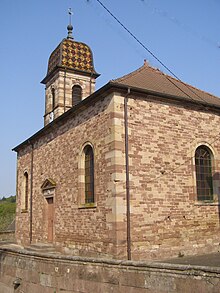Belverne
| Belverne | ||
|---|---|---|

|
|
|
| region | Bourgogne-Franche-Comté | |
| Department | Haute-Saône | |
| Arrondissement | Lure | |
| Canton | Héricourt-2 | |
| Community association | Pays d'Héricourt | |
| Coordinates | 47 ° 38 ' N , 6 ° 39' E | |
| height | 322-500 m | |
| surface | 6.15 km 2 | |
| Residents | 145 (January 1, 2017) | |
| Population density | 24 inhabitants / km 2 | |
| Post Code | 70400 | |
| INSEE code | 70064 | |
 Belverne |
||
Belverne is a municipality in the French department of Haute-Saône in the region Bourgogne Franche-Comté .
geography
Belverne is located at an altitude of 350 m above sea level, 10 km northwest of Héricourt and about 16 km west of the city of Belfort (as the crow flies). The village extends in the southern foreland of the Vosges , in the valley of the Fau , in a cleared island of the densely wooded hill area south of the Chérimont .
The area of the municipality of 6.15 km² covers a section in the southern Vosges foothills. The central part of the area is crossed from east to west by the valley of the Fau , which provides drainage to the Rognon and forms a valley widening at Belverne. The valley is flanked in the north by the steep, wooded slope of the Côte , which leads to the heights of the Chérimont . Belverne's highest point is reached here at 500 m. A saddle leads south to the headwaters of the Ruisseau des Terriers , another tributary of the Rognon. In the southeast the municipal area extends into the forest of the Bois de la Thure (up to 480 m). The predominantly wooded hill country around Belverne forms the southwestern continuation of the Vosges and is partly made of red sandstone , partly of Permian layers.
Neighboring communities of Belverne are Clairegoutte in the north, Étobon and Luze in the east, Champey and Courmont in the south and Lomont in the west.
history
Belverne is first mentioned in documents in 1279. In 1350 the place was sacked. At first Belverne belonged to the lordship of Granges, but in 1397 it passed to the Counts of Montbéliard and was later subordinated to the lordship of Étobon. The Reformation was introduced in 1538. During the Thirty Years War , the place was sacked and devastated in 1635 by troops of Duke Charles of Lorraine-Guise. With the annexation of the county of Württemberg-Mömpelgard (Montbéliard) , Belverne finally came into French hands in 1793. Since 2003 Belverne has been a member of the community association Communauté de communes de Rahin et Chérimont, which comprises nine villages .
Attractions
The Lutheran Church of Belverne was built in 1832 on the site of an earlier church. The parish belongs to the Lutheran parish association Le Mont Vaudois with eleven others . Noteworthy is the Grande Fontaine from 1868 in the center of the village, a roofed lavoir (fountain and wash house) with arcaded arches, which was restored in 1989. Various houses from the 17th to 19th centuries in the traditional Franche-Comté style have been preserved in the town center.
population
| Population development | |
|---|---|
| year | Residents |
| 1962 | 174 |
| 1968 | 182 |
| 1975 | 180 |
| 1982 | 134 |
| 1990 | 128 |
| 1999 | 129 |
| 2006 | 120 |
With 145 inhabitants (January 1, 2017) Belverne is one of the smallest communes in the Haute-Saône department. After the population had decreased significantly in the first half of the 20th century (265 people were still counted in 1886), a temporary trend reversal occurred during the 1960s. Since 1975 the population has decreased again.
Economy and Infrastructure
Until well into the 20th century, Belverne was primarily a village characterized by agriculture (arable farming, fruit growing and cattle breeding) and forestry. In addition, there are now some local small businesses. In the meantime, the village has also turned into a residential community. Many employed people are therefore commuters who go to work in the larger towns in the vicinity and in the Belfort-Montbéliard agglomeration.
The village is well developed in terms of traffic. It is located on the main road D438, which leads from Belfort to Lure , and its four-lane and crossing-free expansion is in progress. Further road connections exist with Courmont and Étobon.
Web links
Individual evidence
- ↑ The other constituent communities are in Brevilliers, Chagey, Champey, Chenebier, Couthenans, Échenans-sous-Mont-Vaudois, Étobon, Héricourt, Luze, Tavey and Trémoins.
- ↑ See "Mont-Vaudois: l'églises ou temples luthériens" , on: Les temples ou églises luthériennes de France , accessed on January 22, 2016.


